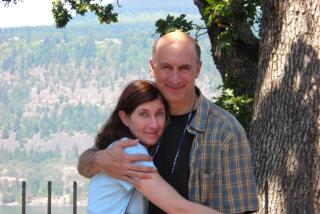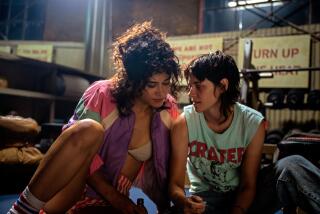Holding On and Letting Go
The mere whisper of their names is painful--Polly Klaas, Danielle van Dam, Elizabeth Smart, Shanta Johnson--for they represent a parent’s unspeakable heartache and a nation’s vicarious nightmare. They are the little girls, and girls are most at risk for such mayhem. Some eventually are found dead; others simply disappear. We read their stories, hear the soundbites and wonder: What really happened to these lost girls? How on Earth do their families survive the horror? How would we bear such a tragedy in our own households? They are questions to which we seldom find answers, turning back ultimately, gratefully, to our happier-by-comparison lives.
Alice Sebold, however, boldly steps into that unimaginable territory in her first novel, “The Lovely Bones.” Sebold’s guide on the journey is 14-year-old Susie Salmon--”like the fish”--who tells us she was murdered in 1973, “before kids of all races and genders started appearing on milk cartons ... back when people believed things like that didn’t happen.”
Susie narrates from her own personal heaven, an in-between place where “life is a perpetual yesterday,” where she gets a sax-playing Vietnamese roommate and where her no-nonsense intake counselor, Franny, eases Susie’s self-doubts with a tart “Don’t mull it over. It does no good. You’re dead and you have to accept it.”
Yet acceptance is exactly what Susie cannot find, and it is that tension that Sebold, a resident of Long Beach and a graduate of UC Irvine’s writing program, so marvelously weaves throughout the novel. Susie relives, in chilling detail, her encounter with her killer and follows his movements after her murder. She longs for Ray Singh, a boy who had a crush on her and with whom she shared an almost-kiss. She lingers at school with her classmates, especially Ruth Connors, a girl she barely knew in life who happened to be standing in her path when her “soul shrieked past Earth.” But most of all, Susie hovers heavily over the lives of her family, anxiously watching her father become obsessed with finding her killer, her mother’s slow withdrawal from her family and marriage, her younger sister’s desperate attempts at toughness, her baby brother’s lonely confusion.
At times Susie’s yearning for the living is so visceral, so acute, that she tries to reach out to them and succeeds: casting her image into a pile of broken glass, communicating with her brother, making a life-changing appearance to Ruth and Ray. At other times, she is a cosmic witness to their pain and anguish, trapped in her inability to be neither on Earth nor in heaven as surely as the ships are trapped in her father’s glass bottles or her beloved penguin is imprisoned in its perfect snow globe world.
Susie’s poignant observations of the living and the chronicle of her own afterlife make “The Lovely Bones” a strange and beautiful amalgam of novelistic styles. At times, when Susie recounts the actions of her killer, the novel reads like a thriller, sweeping us along as we see the killer’s dreams, feel his overwhelming longings to kill again, experience her father and sister’s obsession with linking him to the crime. Yet at other times it is a shattering family drama, the tale of four survivors broken by unspeakable horror who learn to knit their grief and anger into new connections, “sometimes tenuous, sometimes made at great cost, but often magnificent.” And, yet again, it is an oddly affecting coming-of-age novel, the story of a girl who travels from the land of the living, through the in-between space of her personal heaven, to a “wide wide Heaven” where she can finally let go, “hold the world without me in it.”
Indeed, letting go is a leitmotif of “The Lovely Bones,” one that Sebold evokes with a sly inventiveness and lyrical power that are deeply moving and ultimately redemptive. With a well-balanced mix of heavenly humor, Earthbound suspense and keen observation of both sides of Susie’s in-between, Sebold teaches us much about living and dying, holding on and letting go, as messy and imperfect and beautiful as the processes can be--and has created a novel that is painfully fine and accomplished, one which readers will have their own difficulties relinquishing, long after the last page is turned.
More to Read
Sign up for our Book Club newsletter
Get the latest news, events and more from the Los Angeles Times Book Club, and help us get L.A. reading and talking.
You may occasionally receive promotional content from the Los Angeles Times.









